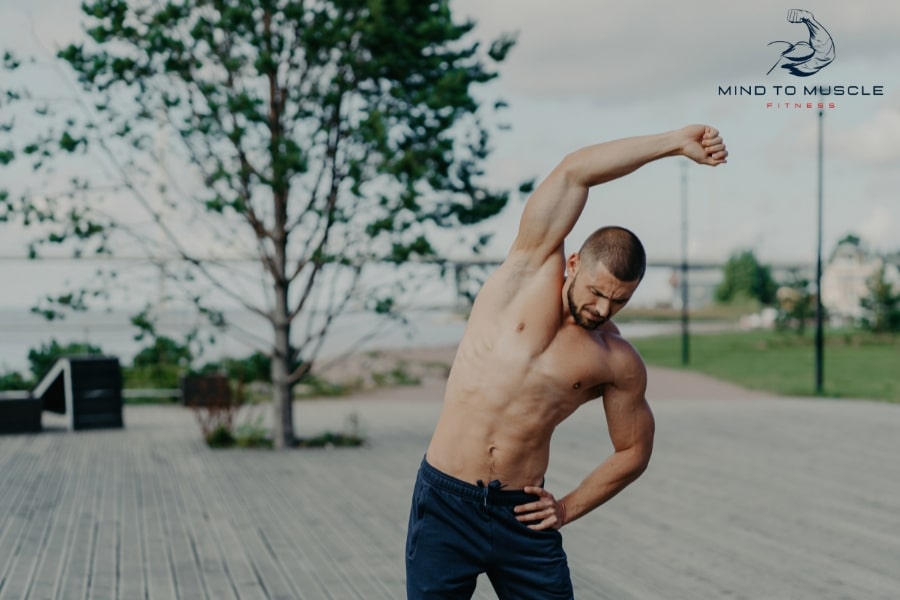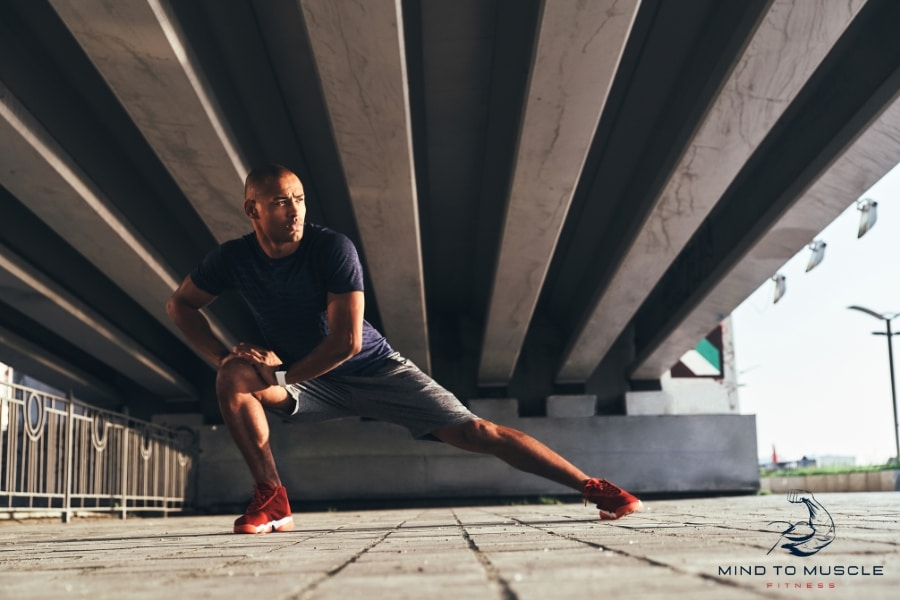
Flexibility Myths Debunked
Ever think if getting less flexible as you age is true? Or if stretching before working out really stops injuries? The fitness world is full of myths. Flexibility myths can hinder your journey if you believe them. Let’s look at what the real deal is with flexibility. It’s important to know the facts, so we value its role in staying healthy and fit. What does flexibility truly mean?
Key Takeaways
- Age is not a barrier to flexibility; a 58-year-old achieved their first split.
- Holding a stretch for 20-30 seconds helps overcome discomfort and boosts flexibility.
- Beginners should aim for 3 sets of 10-15 seconds of stretching.
- Women generally exhibit more flexibility than men.
- Flexibility enhances range of motion and may help in muscle mass development.
Understanding Flexibility: What It Really Means
People often get flexibility wrong, leading to many myths. Some think it’s just about being fit. But knowing what it really is helps crush these myths.
The True Definition of Flexibility
Flexibility is all about your joints’ motion range. This includes how muscles and tissues can stretch. It’s not just about doing a split, but about moving well daily.
Flexibility vs. Mobility
Many mix up flexibility and mobility. They relate, yet act differently. Flexibility is about moving freely but mobility is moving purposefully within that. Getting this right helps in setting up great training plans.
Importance of Flexibility in Daily Life
Flexibility is key beyond just sports. It helps in daily life a lot. It makes you less likely to get hurt and stand straighter. Adding flexibility exercises improves how your body’s parts work together every day.
This insight debunks a bunch of false ideas about flexibility. It shows how crucial it is, not just for athletes, but for all of us. Flexibility plays a vital role in improving overall mobility, reducing the risk of injury, and enhancing physical performance in everyday activities. While many focus solely on strength or endurance training, incorporating stretching and mobility exercises can create a more balanced fitness routine. Understanding the pros and cons of calisthenics can also help tailor a regimen that promotes flexibility, as these bodyweight exercises often require and develop a full range of motion.
Common Flexibility Myths
Flexibility is often misunderstood. Many believe myths that can lead them astray. Let’s unveil the truths and put aside several myths to truly grasp the value and advantages of being flexible for us all.
Myth: Flexibility is Only Important for Athletes
It’s a big myth that only athletes need to be flexible. In fact, flexible bodies are useful for everyone, athlete or not. It makes daily tasks like bending and lifting easier, with less discomfort. Studies show that following flexibility training tips not only increases your movement range but also drops your chances of getting hurt.
Myth: Flexibility Decreases with Age
Some think flexibility always lessens as we get older. Yet, research refutes this, showing stretching keeps flexibility up, even for seniors. So, by sticking to regular stretching, you can hold off on the age-old tale that flexibility simply fades.
- Enhancing range of motion
- Reducing risk of injuries
- Improving overall quality of life
Debunking Flexibility Training Myths
Flexibility training faces myths that stop improvement and bring false ideas. We’ll look closer at two big myths and uncover the facts about each.
Myth: Stretching Before Exercise Prevents Injury
Some think stretching before activities stops injuries. But, a study by the National Institute of Health (NIH) shows stretching alone might not prevent harm.
Dynamic warm-ups, which use moving stretches, are better for readying the body. This way boosts blood flow and makes muscles looser, cutting the chance of getting hurt better than static stretching.
Knowing the correct warm-up method is key to staying fit and avoiding injury.

Myth: You Can Become Flexible Overnight
Many believe becoming flexible is something you can do quickly. But, gaining flexibility takes time and effort. Experts compare getting more flexible to getting stronger. It’s a slow process that needs you to keep at it. Doing stretches regularly and adding flexibility exercises to your daily routine are important for lasting benefits.
By getting rid of these myths, we can use better ways to train and meet our fitness targets safely and well. Just remember, being flexible takes time, patience, and keeping at it.
Stretching Myths Explained and Addressed
Flexibility training has its myths, which can be misleading or risky. We will tackle two big myths with the truth.
Myth: Stretch Until It Hurts
Have you heard that stretching must hurt to work? Seems logical – no pain, no gain, right? But, experts say this isn’t true. Stretching should never be painful. It should challenge you, but not hurt.
So, a good stretching routine includes starting gently and moving smoothly to more intense stretches. This keeps your flexibility improving without any harm. Getting rid of these myths helps us stretch more safely and effectively.
Myth: Static Stretching is the Best Method
Then, there’s the idea that holding a stretch is the best way to get flexible. But, new studies found this might not be right. In 2015, a study in the Clinical Journal of Sport Medicine said static stretching doesn’t prevent injuries and can actually make joints looser, raising injury risks.
Plus, a different study in 2014, in the Journal of Strength Conditioning and Research, found that deep stretching before tough work can lower your strength, speed, and overall performance. Mix it up with dynamic and active stretching for better results in both flexibility and performance.
Take yoga, for example, it focuses on more than just flexibility. It’s about breathing, balancing your nervous system, getting strong, and staying balanced. This all helps you become more flexible in a healthier way.
Flexibility Myths Impact on Your Fitness Routine
Believing in common flexibility misconceptions can slow your fitness progress and bring injury risks. Thinking you can get flexible overnight might make you overdo it. This can cause muscle strains or worse. Knowing that becoming flexible takes time is key. It helps set achievable goals and avoids setbacks.
If you buy into flexibility exercise myths, your fitness plan could go off course. Some myths say that just doing static stretching is enough. But, dynamic stretching can be better before you work out. By learning the truth, you can make your fitness plan better. This way, you keep your muscles healthy and boost your performance.
It’s also good to know that flexibility isn’t just for athletes. This knowledge opens new paths to better fitness and health. It’s not just about hitting certain goals but feeling your best. By getting rid of these flexibility myths, you make your workouts safer and more effective.
Conclusion
I hope you’ve learned a lot about stretching and flexibility from this article. Many myths around flexibility can slow down our fitness goals. But knowing the truth helps us move forward safely.
It’s important to see that flexibility and mobility are not the same. And don’t believe that you lose flexibility with age. We explored how important flexibility is for everyone, not just athletes.
Next steps include using science to boost your flexibility. This approach lowers your injury risk. So, let’s leave the myths behind. Instead, focus on a smart and well-rounded strategy. This way, your journey to better health is based on truth, not fiction.
FAQ
What are some common flexibility myths?
Many people used to think flexibility was only for athletes. They also believed it naturally decreases as we get older. And that stretching before working out always stops injuries. But, experts in sports and science have shown these ideas are wrong.
Is flexibility the same as mobility?
Flexibility and mobility are two different things. Flexibility means a muscle’s ability to stretch. Mobility is how well a joint moves, which involves many body parts. Both are key for good health.
Why is stretching before exercise not always effective in preventing injuries?
Stretching before working out is not a perfect injury shield. It only makes your muscles longer. To really prevent injuries, you need to strengthen them. Your warm-up should match the activities of your main exercise.
Can anyone become flexible overnight?
Sadly, becoming flexible doesn’t happen quickly. It needs constant, correct practice. Any shortcuts are risky and could harm you. Opt for slow, steady stretching routines for the best outcome.
Should I stretch until it hurts?
You should never stretch to the point it hurts. Stretching is about making your muscles feel good, not bad. If it hurts, you’re going too far and might hurt yourself.
Is static stretching the best method?
Static stretching isn’t always the top option. Though it does help your flexibility, dynamic stretching might suit you better. Dynamic stretching warms up your muscles with movement, making them ready to work.
Why is flexibility important for daily life?
Flexibility matters a lot every day. It lets you move better when you bend, reach, or turn. Being flexible means you’re less likely to get hurt. It also keeps your muscles from feeling stiff, making you feel better overall.
Does flexibility decrease with age?
Usually, flexibility drops as we age, but you can fight it. Regular stretching keeps you flexible. Staying active as you get older is vital for staying limber.
How can believing in flexibility myths impact my fitness routine?
Relying on myths can mess up your workout. Doing too much static stretching before or only stretching can harm you. Knowing the truth helps you build a safe and balanced exercise plan.



